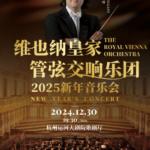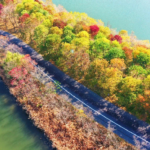The ancient capital of Nanjing, a city blessed with the beauty of mountains and rivers, and steeped in the history of rise and fall, is a place that resonates with the imagination and emotions of poets and scholars. Known as the City of Greenery, City of Literature, and City of Universal Love, it has long been celebrated. The Zijin Mountain, also known as ‘Bell Mountain,’ has been hailed as one of the ‘Four Famous Mountains of the South of the Yangtze River’ since ancient times.
Here, the natural scenery is rich and beautiful, and the cultural heritage is profound and extensive, with three core scenic areas: the Sun Yat-sen Mausoleum, the Ming Xiaoling Mausoleum, and the Linggu Temple. The forest coverage rate exceeds 80%, and the harmonious integration of mountain, water, city, and forest creates a stunning beauty, making it the city’s living room where the ancient capital meets the world. What you see now is the Music Stage. Designed by Chinese architectural masters Guan Songsheng and Yang Tingbao, its layout and elevation are shaped by the natural contours of the mountain, drawing inspiration from nature. While absorbing the characteristics of ancient Greek architectural art, it also integrates elements of classical Chinese Jiangnan gardens, offering a spacious feel and exquisite decorative artistic style, living in harmony with the natural scenery. The fusion of Chinese and Western architectural cultures coexists, like a beautiful fan shell inlaid among the mountains and forests, radiating a unique artistic charm. Time passes, but classics remain evergreen. In recent years, the ‘Nanjing Forest Music Festival’ has made this Music Stage, which has weathered more than 80 years, even more elegant and poised, full of vitality, and a dynamic architectural note in the Zhongshan Scenic Area. The Sun Yat-sen Mausoleum, located on the southern slope of Zijin Mountain, is the tomb of the great pioneer of the democratic revolution, Dr. Sun Yat-sen. The main buildings of the Sun Yat-sen Mausoleum include: the memorial arch, the tomb path, the tomb gate, the stele pavilion, the memorial hall, and the tomb chamber. From an aerial view, it resembles a ‘bell shape,’ symbolizing the continuous ringing of the bell to awaken the people. The architectural design is ingenious and unique, blending the essence of ancient Chinese and Western architecture. In 1912, when Sun Yat-sen took office as the provisional president in Nanjing, he visited Zijin Mountain and, impressed by its majestic scenery with plains in front and green mountains behind, said to his entourage, ‘When I pass away, I wish to ask the nation for a handful of soil to rest my body. ‘ In 1925, Dr. Sun Yat-sen passed away in Beijing and once again instructed, ‘After my death, I wish to be buried in Nanjing Zijin Mountain because Nanjing is where the provisional government was established, and thus I do not forget the Xinhai Revolution.’ To respect Dr. Sun Yat-sen’s last wishes, Sun Ke and other relatives and members of the funeral preparation office visited Zijin Mountain three times to inspect the site, ultimately choosing the southern slope of Maoshan in Zijin Mountain as the location for the tomb. The construction of the Sun Yat-sen Mausoleum began in the spring of 1926 and was completed in 1932, taking six years. The entire architectural style of the Sun Yat-sen Mausoleum is simple and grand, integrating architectural art with the essence of Dr. Sun Yat-sen’s thoughts, and is a classic of modern Chinese tombs. In the Zhongshan Scenic Area, there is an aerial necklace made of plane trees, with seasons changing and colors transforming, golden romance and emerald elegance, adorning the scenery of all four seasons.The gem pendant of that necklace is Meiling Palace. Meiling Palace is a Chinese-Western hybrid building built against the mountain. The exterior of Meiling Palace is extremely rich in Chinese classical charm. The interior decoration is in Western style. The spatial levels are well-proportioned. The building has a hall, living room, grand banquet hall, bedroom, study, and Kaige Church. The overall building design combines traditional Chinese architectural culture with Western modern architectural techniques and reaches a realm in the history of Chinese architecture. Opening hours: Open from 09:30 to 21:00 all year round.










